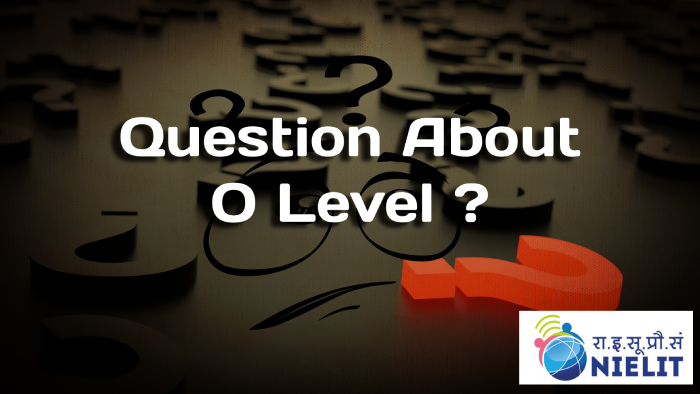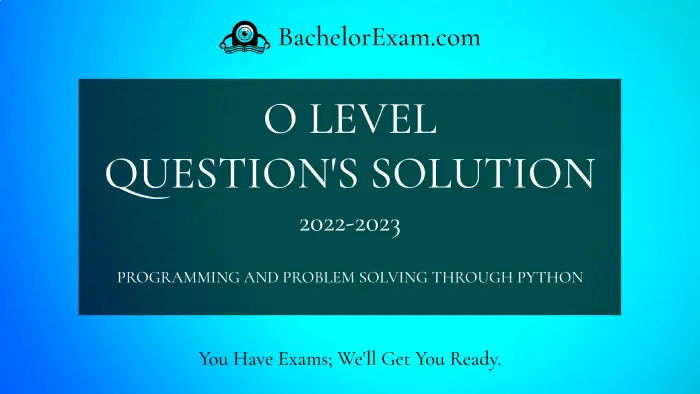Hello everyone🙏, Today, we’re going to give you the answers to the August O Level Previous Year Questions for PROGRAMMING AND PROBLEM SOLVING THROUGH PYTHON LANGUAGE. I hope that session is enjoyable for you and that it will be beneficial for your exams. ❤️Please feel free to contact us if you have any questions. Message us.
Important Questions- O Level NIELIT | PROGRAMMING AND PROBLEM SOLVING THROUGH PYTHON LANGUAGE:
1. कौन सा फंक्शन स्ट्रिंग्स को रिटर्न करता है ?
- (A) readline()
- (B) read()
- (C) उपरोक्त दोनों
- (D) उपरोक्त में से कोई नहीं
Which function returns the strings?
- (A) readline()
- (B) read()
- (C) Both of the above
- (D) None of the above
2. निम्नलिखित सूडोकोड का आउटपुट क्या होगा, जहां ^, XOR ऑपरेशन को दर्शाता है ?
Integer a, b, c
Set b=4, a=3
c=a^b
Print c
- (A) 4
- (B) 3
- (C) 5
- (D) 7
What will be the output of the following pseudocode, where a represent XOR operation?
Integer a, b, c
Set b = 4, a = 3
c=a^b
Print c
- (A) 4
- (B) 3
- (C) 5
- (D) 7
3. फ़ाइल खोलने के लिए निम्न में से कौन सा सही मोड नहीं है?
- (A) ab
- (B) rw
- (C) a+
- (D) r+
Which of the following is not a correct mode to open a file?
- (A) ab
- (B) rw
- (C) a+
- (D) r+
4. निम्नलिखित कोड से कितनी संख्याएँ प्रिंट होंगी ?
def fun(a,b):
for x in range(a,b+1):
if x%3==0:
print(x, end=””)
fun(100,120)
- (A) 7
- (B) 8
- (C) 6
- (D) 9
How many numbers will be printed by the following code?
def fun(a,b):-
for x in range(a,b+1):
if x%3==0:
print(x, end=””)
fun(100,120)
- (A) 7
- (B) 8
- (C) 6
- (D) 9
5. निम्नलिखित कोड का आउटपुट क्या है ?
a=11:”A”, 2: “B”, 3: “C”)
b=14: “D”, 5: “E”)
a.update(b)
print(a)
- (A) (1: ‘A’, 2: ‘B’, 3: ‘C’)
- (B) (1: ‘A’, 2: ‘B’, 3: ‘C’, 4: ‘D’, 5: ‘E’)
- (C) Error
- (D) (4: ‘D’, 5: ‘E’)
What is the output of the following code ?
a={1:”A”, 2: “B”, 3: “C”}
b = (4: “D”, 5: “E”}
a.update(b)
print(a)
- (A) (1: ‘A’, 2: ‘B’, 3: ‘C’)
- (B) (1: ‘A’, 2: ‘B’, 3: ‘C’, 4: ‘D’, 5: ‘E’)
- (C) Error
- (D) (4: ‘D’, 5: ‘E’}
6. निम्नलिखित में से कौन सी भाषा कंप्यूटर द्वारा समझी जाती है ?
- (A) मशीन लैंगवेज
- (B) असेंब्ली लैंगवेज
- (C) हाई लेवल
- (D) उपरोक्त में से कोई नहीं
Which of the following language is understood by computer?
- (A) Machine language
- (B) Assembly language
- (C) High-level language
- (D) None of the above
7. निम्नलिखित कथनों के बाद आउटपुट क्या होगा ?
a=0
b=3
while a + b < 8:
á += 1
print(a, end=”)
- (A) 01234
- (B) 123456
- (C) 12345
- (D) इनमें से कोई नहीं
What will be the output after the following statements?
a=0
b=3
while a + b < 8:
a+= 1
print(a, end=”) .
- (A) 01234
- (B) 123456
- (C) 12345
- (D) None of these
8. निम्मलिखित कोड का आउटपुट क्या होगा ?
def disp(*arg):
for i in arg:
print(i)
disp(name=”Rajat”, age=”20 )
- (A) TypeError
- (B) Rajat 20
- (C) Name age
- (D) इनमें से कोई नहीं
What is the output of the following code?
def disp(*arg):
for i in arg:
print(i) disp(name=”Rajat”, age=”20″)
- (A) TypeError
- (B) Rajat 20
- (C) Name age
- (D) None of these
9. एक कंप्यूटर प्रोग्राम जो कंप्यूटर की गतिविधि का प्रबंधन और नियंत्रण करता है।
- (A) इंटरप्रीटर
- (B) मॉडम
- (C) कंपाइलर
- (D) ऑपरेटिंग सिस्टम
A computer programme that manages and controls a computer’s activity :
- (A) Interpreter
- (B) Modem
- (C) Compiler
- (D) Operating system
10. हम पायथन में एक खाली सूची कैसे बना सकते हैं?
- (A) list = ()
- (B) list.null
- (C) null.list
- (D) list= []
How can we create an empty list in Python?
- (A) list = ()
- (B) list.null
- (C) null.list
- (D) list = []
11. निम्नलिखित कथनों के बाद आउटपुट क्या होगा ?
x = 2
if x < 5:
print(x)
else:
pass
- (A) 234
- (B) 1234
- (C) 2
- (D) इनमें से कोई नहीं
What will be the output after the following statements?
X = 2
if x < 5:
print(x)
else:
pass
- (A) 234
- (B) 1234
- (C) 2
- (D) None of these
12. बाइनरी प्रारूप में डेटा राइटिंग के लिए उपयोग किया जाने वाला फंक्शन।
- (A) write
- (B) output
- (C) send
- (D) dump
A function used for writing data in the binary format :
- (A) write
- (B) output
- (C) send
- (D) dump
13.फंक्शन कॉल के पैरामीटर और लोकल वेरिएबल को सिस्टम मेमोरी के किस हिस्से में स्टोर करता है?
- (A) हिप
- (B) स्टैक
- (C) अनइनिशियलाइज़्ड डाटा सेगमेंट
- (D) उपरोक्त में से कोई नहीं
Which part of the memory does the system store the parameter and local variables of a function call ?
- (A) heap
- (B) stack
- (C) Uninitialized data segment
- (D) None of the above
14. निम्नलिखित का आउटपुट क्या होगा ?
def iq(a,b):
if(a==0):
return b
else:
return iq(a-1,a+b)
print(iq(3,6))
- (A) 9
- (B) 10
- (C) 11
- (D) 12
What will be the output of the following?
def iq(a,b):
if(a==0):
return b
else:
return iq(a-1,a+b)
print(iq(3,6))
- (A) 9
- (B) 10
- (C) 11
- (D) 12
15. नीचे दिए गए प्रोग्राम का आउटपुट क्या है?
def maximum(x, y):
if x > y:
return x elif x == y:
return ‘The numbers are equal’
else:
return y
print(maximum (2, 3))
- (A) 2
- (B) 3
- (C) The numbers are equal
- (D) उल्लिखित में से कोई नहीं
What is the output of below program ?
def maximum(x, y):
if x > y:
return x elif x == y:
return ‘The numbers are equal’
else:
return y
print(maximum (2, 3))
- (A) 2
- (B) 3
- (C) The numbers are equal
- (D) None of the options
16. पैकेज से सभी मॉड्यूल इम्पोर्ट करने के लिए कौन सा कथन सही है।
- (A) from package import all
- (B) from package import *
- (C) from package include all
- (D) from package include *
Which statement is correct to import all modules from the package ?
- (A) from package import all
- (B) from package import *
- (C) from package include all
- (D) from package include *
17. निम्नलिखित का आउटपुट क्या होगा ?
import numpy as np
a = np.array([2, 3, 4, 5])
b= np.arange(4)
print(a+b)
- (A) [2345]
- (B) [3456]
- (C) [1234]
- (D) [2468]
What will be the output of the following?
import numpy as np
a = np.array([2, 3, 4, 5])
b = np.arange(4)
print(a+b)
- (A) [2345]
- (B) [3 4 5 6]
- (C) [1234]
- (D) [2 4 6 8]
18. निम्नलिखित का आउटपुट क्या होगा?
import numpy as np
print(np.maximum ([2, 3, 4], [1, 5, 2]))
- (A) [152]
- (B) [154]
- (C) [234]
- (D) [254]
What will be the output of the following?
import numpy as np
print(np.maximum([2, 3, 4], [1, 5, 2]))
- (A) [152]
- (B) [154]
- (C) [234]
- (D) [254]
19. निम्नलिखित का आउटपुट क्या है?
print(int())
- (A) कोई यादृच्छिक संख्या
- (B) 1
- (C) 0
- (D) Error
What is the output of the following?
print(int())
- (A) Any random number
- (B) 1
- (C) 0
- (D) Error
20. निम्नलिखित में से किस डेटा प्रकार में, डुप्लिकेट आइटम की अनुमति नहीं है ?
- (A) लिस्ट
- (B) डिक्शनरी
- (C) सेट
- (D) उपरोक्त में से कोई नहीं
In which of the following data type, duplicate items are not allowed?
- (A) list
- (B) dictionary
- (C). set
- (D) None of the above.
21. निम्नलिखित कथन का आउटपुट क्या है ?
print ((2, 4)+(1, 5))
- (A) (2,4), (4, 5)
- (B) (3,9)
- (C) (2, 4, 1, 5)
- (D) Invalid Syntax
What is the output of the following statement ?
print ((2, 4)+(1,5))
- (A) (2, 4), (4, 5)
- (B) (3,9)
- (C) (2, 4, 1, 5)
- (D) Invalid Syntax
22. निम्नलिखित कोड का आउटपुट क्या होगा?
import numpy as np
a = np.array([[1,2,3],[0,1,4],[11,22,33]])
print (a.size)
- (A) 1
- B) 3
- (C) 9
- (D) 4
What will be output for the following code?
import numpy as np
a = np.array([[1,2,3],[0,1,4], [11,22,33]])
print (a.size)
- (A) 1
- (B) 3
- (C) 9
- (D) 4
23. निम्नलिखित में से कौन सी वैरिएबल डिंक्लेरेशन गलत है ?
- (A) a_=3
- (B) a=3
- (C) a?=3
- (D) सभी
Which of the following variable declaration is incorrect?
- (A) a_=3
- (B) a=3
- (C) a?=3
- (D) All of these
24._________ करेंट लूप आइटरेशन को तुरंत समाप्त कर देता है।
- (A) break
- (B) pass
- (C) continue
- (D) इनमें से कोई नहीं
__________ immediately terminates the current loop iteration.
- (A) break
- (B) pass
- (C) continue
- (D) None of these
25. कौन सा फंक्शन दो अर्गुमेंट लेता है ?
- (A) dump()
- (B) laod()
- (C) उपरोक्त दोनों
- (D) उपरोक्त में से कोई नहीं
Which of the function takes two arguments ?
- (A) dump()
- (B) laod()
- (C). Both of the above
- (D) None of the above
The rest of the question is attached in PDF. You can click here to Check the PDF
Important O Level links – NIELIT
| Name | Official Links |
|---|---|
| Download Admin Card: | Admin Card |
| Syllabus: | Download Syllabus |
| Official Website: | Website |
| O Level Certification | Website |
Previous Year Question Paper – O Level NIELIT
| Name | Official Links |
|---|---|
| INFORMATION TECHNOLOGY TOOLS AND NETWORK BASICS | IT-Tool-and-Network Basics |
| PROGRAMMING AND PROBLEM SOLVING THROUGH PYTHON LANGUAGE | Programming-&-PS-Python |
| WEB DESIGNING & PUBLISHING | WEB-DESIGNING-PUBLISHING |
| Internet of Things | Internet-of-Things |
Important Questions Paper For O LEVEL
| Name | Official Links |
|---|---|
| Important for INFORMATION TECHNOLOGY TOOLS AND NETWORK BASICS | Top Important Question |
| Important for Web Designing | Top Important Question |
| Important For INTERNET OF THINGS | Top Important Question |
| Important For PROGRAMMING AND PROBLEM SOLVING THROUGH PYTHON LANGUAGE | Top Important Question |
What is ‘O’ Level:



Is O level HARD..?
I know There are lot of question in your pockets . But now chill Time to explore that type of question Click here to Explore Questions
I know that a lot of people are very interested in this topic.🤷♂️ The bachelor’s exam will help to clarify this, so don’t worry. Let’s discuss the issue of direction. We are creating a separate blog for this subject in the hopes that it will help you understand the “O” Level. Click here to explore ‘O’ Level.😎
Programming and Problem Solving Through Python Language PDF
Pdf for ‘O’ Level Previous Year Question’s Solution (Aug-2022) – PROGRAMMING AND PROBLEM SOLVING THROUGH PYTHON LANGUAGE
FAQ (Frequently Asked Question)
is o level hard?
Exams demand time and commitment to study for O Levels. As a private applicant studying for the GCE O-Levels, it can be tough to concentrate. Students who achieve a minimum of 50% in both theory papers and the practical exam are considered pass. Qualifying students must apply for a Provisional Certificate.

1 thought on “O Level Previous Year Question’s Solution (Aug-2022) – PROGRAMMING AND PROBLEM SOLVING THROUGH PYTHON LANGUAGE”